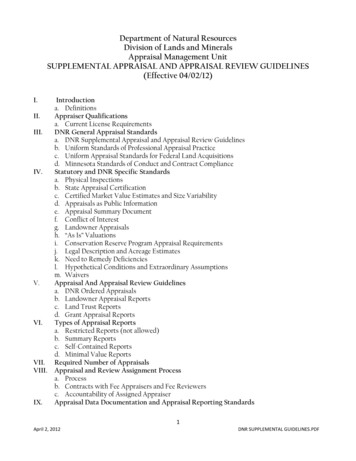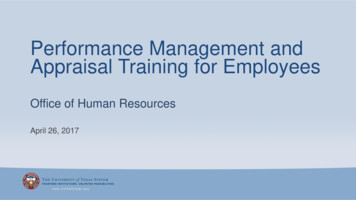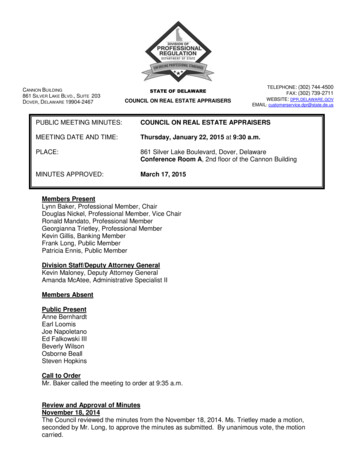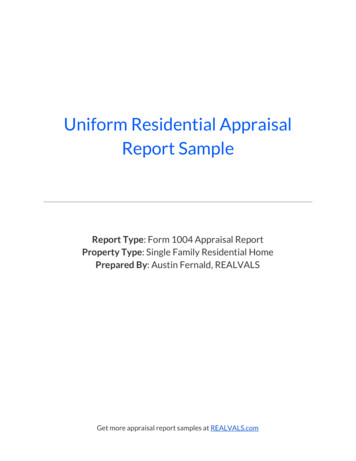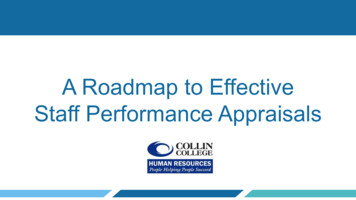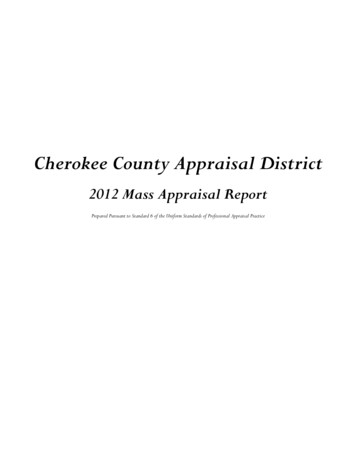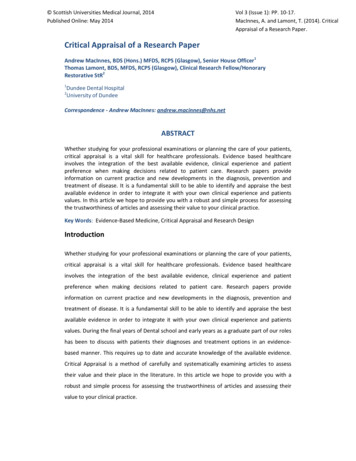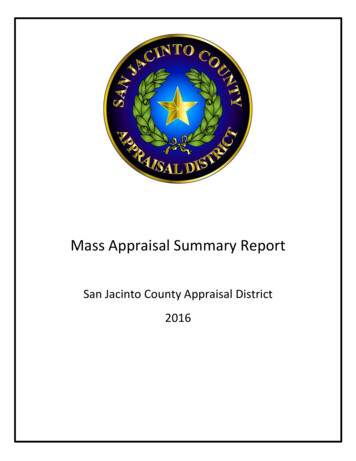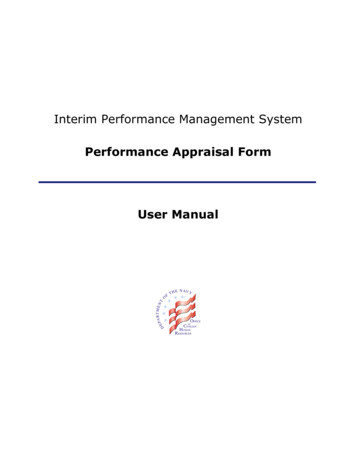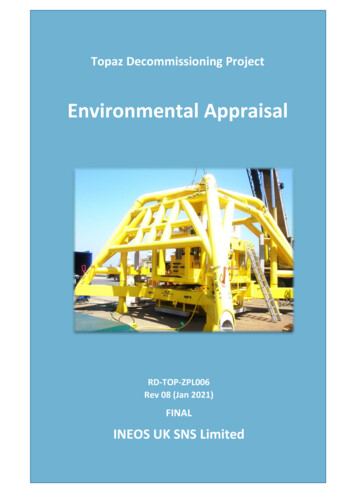
Transcription
Topaz Decommissioning ProjectEnvironmental AppraisalRD-TOP-ZPL006Rev 08 (Jan 2021)FINALINEOS UK SNS Limited
INEOS Oil & Gas UKDocument Number. RD – TOP– ZPL006 – 8revCONTROLLED DOCUMENTTitle:Topaz Decommissioning ProjectEnvironmental AppraisalFINALNotes:This is a report of the Environmental Appraisal (EA) undertaken as part of the TopazDecommissioning Project. The EA considers the potential environmental impact ofdecommissioning the Topaz subsea wellhead and associated pipelines.Revision Record:822-01-21P JonesNHD ScottCEOD Scott22-01-21719-11-20P Jones-----603-04-20P Jones-----519-03-20P Jones-----425-02-20P Jones-----326-11-19R O’Sullivan-----201-10-19R O’Sullivan-----126-07-19P Jones-----0Mar-19R O’Sullivan-----DateRev.AuthorPreparedDocument ument Approval for use by INEOS Oil & Gas UKThe master original of this document is held by:POST CONSULTATION DRAFTSHEQPage 2 of 37Uncontrolled if printed
INEOS Oil and Gas UKEXECUTIVE SUMMARYThe Topaz Field is located approximately 130km northeast of the UK coastline (Norfolk) and42km west of the UK-Netherlands median line. It produced gas and condensate and is tiedback to the DNO North Sea (ROGB) Limited Schooner platform, 15.5km to the northwest. Itused a 6.6” export pipeline, a 3.6” umbilical providing control and chemical injection in orderto operate. Topaz production ceased in October 2017.The Topaz subsea wellhead is protected by a wellhead protection structure. The gas pipelineand umbilical were cleaned/flushed in 2019. The decommissioning works will take placebetween 2021-23, and will involve removal of the wellhead protection structure and two pilesdown to 3m below the seabed, removal of the tie-in spools and exposed sections of thepipeline and retrieval of mattresses where possible. A comparative assessment has beenundertaken and identified that the most appropriate option is to leave the pipeline in situ.This Environmental Appraisal reviews the potential environmental impacts that the proposeddecommissioning operation (described in RD-TOP-ZPL004) could have, in line with therequirements of the OPRED guidance (2018).Background environmental information indicates that Topaz is located within an area of sandwith some areas of gravel and cobbles and undergoes high energy wave action. This physicalenvironment impacts the species that are dominant in the area. Benthic species are used tonatural seabed disturbance and are dominated by polychaetes, crustaceans and molluscs.The area is used as a nursing ground for twelve fish species and a spawning ground for tenspecies including cod, whiting, sandeel and mackerel. Seabirds are particularly sensitive to oilon the surface of the water in March, between June and September and in December. Speciescommon in this part of the Southern North Sea include Common guillemot, Northern fulmarsand Black-legged kittiwake. There is the potential that up to three marine mammal species(harbour porpoise, Minke whale and white-beaked dolphin) may be present in the area ofTopaz, with June and July seeing the highest densities. Topaz is situated at the outermostreach of the most common excursions of harbour and grey seals coming from Donna Nookand the Wash areas. Topaz is also located approximately 28km from the Southern North SeaSAC for harbour porpoise, 28km south of the North Norfolk and Saturn Reef SAC and 33kmfrom the Dogger Bank SAC.Comparison of the proposed activities with the requirements of the East Offshore Marine Planhas been made. This includes consideration of other sea users, biodiversity, hazardoussubstance release and emissions to air. It has been concluded that this operation is in linewith its principles.The potential impacts of the proposed activities have been reviewed; each potential impact onthe surrounding environment was classified as being low, medium or high. Impacts that weredetermined to be low have not been considered in detail. Those that may potentially have amedium or high impact were assessed and mitigation and control measures identified. Thesemeasures have reduced the anticipated impact to low levels. Other projects within the areahave also been considered and the cumulative impact assessed.It has been determined that, if the control and mitigation measures identified are put in place,there should be no significant long term or lasting impact on the surrounding environment.FINAL3Uncontrolled if printed
INEOS Oil and Gas UKTable of Contents1Introduction . 61.1Overview. 61.2Purpose and Scope . 61.3Regulatory Context . 61.4Stakeholder Engagement. 62Environmental Appraisal Process . 73Decommissioning Project Scope. 843.1Infrastructure. 83.2Pre-Decommissioning Activities . 83.3Proposed Decommissioning Activities. 93.4Post-Decommissioning Activities . 113.4.1Debris Clearance and Over-trawl Assessment . 113.4.2Monitoring and Evaluation. 113.5Waste Management . 113.6Vessel Use . 123.7Schedule . 123.8Environmental Management . 12Environmental Baseline . 144.14.1.1Sediments. 144.1.2Oceanography and Meteorology . 144.2Biological Environment . 144.2.1Benthos . 144.2.2Fish and Shellfish . 154.2.3Seabirds . 174.2.4Marine Mammals . 194.35Physical Environment . 14Socio-Economic . 204.3.1Commercial Fisheries . 204.3.2Shipping. 204.3.3Other Marine Users. 204.3.4Protected Areas . 214.3.5Marine Plans . 22Initial Assessment . 245.1FINALMedium and High Significance . 254Uncontrolled if printed
INEOS Oil and Gas UK5.1.1Seabed Disturbance . 255.1.2Unplanned Discharges. 275.2Low Significance . 285.2.1Atmospheric Emissions . 285.2.2Underwater Noise . 295.2.3Discharges to Sea . 305.2.4Waste Production . 305.2.5Light Emissions. 305.2.6Safety Risk to Other Sea Users . 305.2.7Socio-economic Impacts . 315.2.8Cumulative Impacts . 315.2.9Transboundary Impacts . 336Conclusions . 347References . 35TablesTable 3-1 Summary of Decommissioning Activities . 10Table 3-2 Outline of the proposed schedule for the Topaz Decommissioning Project . 12Table 4-1 Potentially spawning and nursing fish species in the Topaz area . 16Table 4-2 Seabird Oil Sensitivity in the area around Topaz . 17Table 4-3 Marine mammal density in the Topaz area . 19Table 4-4 Value and weight of fish landed in 36F2 and the UK. . 20Table 4-5: Relevant East Offshore Marine Plan Policies . 22Table 5-1 A summary of the potential impacts associated with the Topaz DecommissioningProgramme prior to control and mitigation measures . 24Table 5-2 Summary of seabed area that will be affected . 25Table 5-3 Estimated Emissions to Air Resulting from Fuel Usage . 28FiguresFigure 3-1 Field Layout . 8Figure 4-1 Seabird sensitivity around Topaz Block 49/2 . 18Figure 5-1 Activities occurring within the vicinity of Topaz . 32FINAL5Uncontrolled if printed
INEOS Oil and Gas UK1 Introduction1.1OverviewThe Topaz Field is located approximately 130km northeast of the UK coastline (Norfolk) and42km west of the UK-Netherlands median line, with a water depth of 34 metres. It producedgas and condensate and is tied back to the DNO North Sea (ROGB) Limited Schoonerplatform, 15.5km to the northwest. It used a 6.6” export pipeline, a 3.6” umbilical providingcontrol and chemical injection in order to operate. Topaz production ceased in October 2017.1.2Purpose and ScopeThe purpose of this Environmental Appraisal (EA) is to identify potential impacts that thedecommissioning of Topaz could have on the surrounding environment, and assess thesignificance of those impacts. Mitigation and control measures will then be determined toreduce the level of the impacts to as low as reasonably practicable (ALARP).The EA will consider all offshore operations associated with the decommissioning of the Topazsubsea wellhead protection structure and pipelines (PL2631 and PLU2632), however it willnot include impacts associated with waste management onshore as this will be consideredelsewhere.1.3Regulatory ContextThe Department for Business, Energy and Industrial Strategy (BEIS) through its OffshorePetroleum Regulator for Environment and Decommissioning (OPRED), regulatesdecommissioning activity in the North Sea. The Petroleum Act 1998 requires that an approvedDecommissioning Programme is in place before commencing activities; a formalenvironmental impact assessment is not required however according to OPRED guidance(2018) an environmental appraisal must be conducted to determine the potential impact of theproposed activities.INEOS Oil and Gas UK has an ISO14001 certified Environmental Management System (EMS)which constitutes part of the Business Management System. The decommissioning of Topazwill be undertaken in line with the requirements of the BMS.1.4Stakeholder EngagementStakeholder engagement is an important aspect of the appraisal process; involving interestedparties from the beginning of the project to the end ensures that opinions can be heard, ideasevolved and expectations managed. Informal responses received from stakeholders will beincorporated as appropriate and the formal consultation process will be undertaken onsubmission of the draft Decommissioning Programme. Section 5 of the DecommissioningProgramme provides a summary of stakeholder comments.FINAL6Uncontrolled if printed
INEOS Oil and Gas UK2 Environmental Appraisal ProcessOPRED guidance (2018) identifies that the environmental appraisal should be proportionalwith respect to the proposed activities, the potential environmental impacts and thesensitivities of the marine environment in the vicinity of the activities.In order to undertake the Environmental Appraisal the activities described within the scopewere reviewed to consider the potential impact on the surrounding environment; this includesbiological, physical and socio-economic impacts. The surrounding environment is describedin Section 4; this information was used to identify potential aspects. The potential impact oneach aspect has been assessed using the matrix presented in Section 5. The extent andduration of the impact has been used to allocate a level of significant from low to high. Controland mitigation measures have then been described and the level of significance reassessed.OPRED guidance (2018) indicates that unplanned or accidental events do not need to beassessed fully, however consideration has been given to the likelihood of the event occurringand details of the location of further information has been provided.FINAL7Uncontrolled if printed
INEOS Oil and Gas UK3 Decommissioning Project ScopeThis section describes the Topaz infrastructure and the proposed decommissioning plans.Further details of the options that have been considered are provided in the ComparativeAssessment (RD-TOP-ZPL005).3.1InfrastructureINEOS UK SNS Limited is the installation operator of the Topaz well and gas export pipelineand umbillical. The wellhead protection structure is held in place by two piles. The gas andcondensate was exported via the 6.6” diameter 15.5 km long export pipeline to DNO NorthSea (ROGB) limited Schooner platform located in Block 44/26. Thereafter it was comingledand exported via a 28km 16” pipeline to Murdoch (owned and operated by ConocoPhillips)and then via the Caister Murdoch System 26-inch wet gas trunk line, to the Theddlethorpe gasterminal. Methanol supplied to Topaz via Murdoch and Schooner was provided via the existingmethanol service line to Murdoch from the Theddlethorpe gas terminal.There are no pipeline crossings on the Topaz to Schooner export pipeline. Figure 3-1 belowpresents the field layout.Figure 3-1 Field Layout15.72km 6.6-inch pipeline15.85km 3.6-inch umbilical3.2Pre-Decommissioning ActivitiesSurveys of the pipeline have been conducted to determine depth of burial. These wereconducted in 2012, 2015 and 2019. The pipeline is buried throughout its entire length (otherthan at either end) and the average depth of the pipeline was 1.29m in 2012 and 1.56m in2015. The average depth of the 3.6” umbilical was 1.22m in 2012 and 1.19m in 2015. Depthsof cover along the umbilical route remained similar indicating the umbilical burial is stable.Interim surveys conducted in 2019 confirmed no freespans or exposures exist on either line.FINAL8Uncontrolled if printed
INEOS Oil and Gas UKMattresses and grout bags have been used at the wellhead and the platform end of the lines.These will be removed. Rock dump was used at 14 locations along the pipeline route in orderto protect the line. These will remain in situ.The survey results were used as part of the Comparative Assessment (RD-TOP-ZPL005)which concluded that leaving the pipeline in situ would have the least impact on the seabed.The pipeline has been flushed and flooded to remove residual hydrocarbons. Prior to thecommencement of decommissioning, the well will be plugged and abandoned to comply withHealth and Safety Executive (HSE) “Offshore Installations and Wells DCR 1996” and inaccordance with Oil and Gas UK (OGUK) Guidelines for the “Suspension and Abandonmentof Wells" (Issue 6, June 2018) as it meets BEIS and HSE requirements. A Master ApplicationTemplate (MAT) and the supporting Subsidiary Application Templates (SAT) will be submittedin support of works carried out. A PON5 will also be submitted to the Regulator for applicationto plug and abandon the wells.3.3Proposed Decommissioning ActivitiesThe proposed decommissioning activities have been outlined in detail in the DecommissioningProgramme. The proposed activities are summarised as follows. The subsea well abandonment will be completed using a jack-up drilling rig. Thepipeline cutting and burial works shall be undertaken using specialist constructionsupport vessel or multi support vessel. The mattresses and stabilisation materials will be removed using specialist ROVs.These are designed to be able to lift mattresses using a series of hooks and bringthem to the surface for recycling and disposal. If the mattresses do not remain intactduring the ascent, the pieces can be ‘grabbed’ by an additional ROV fitting ensuringthat all debris is removed. The Topaz well will be plugged and abandoned in accordance with Oil & Gas UKguidelines; The wellhead protection structure will be removed and recycled or disposed onshore; The gas export pipeline will be partially removed. The tie-in spools will be removedand recycled or disposed onshore. The exposed sections at both ends will beremoved or lowered to achieve adequate depth of coverage with best endeavours toachieve -0.6m. The existing buried sections of pipeline will be left in situ; The umbilical will be partially removed. The exposed sections adjacent to the Topazwell and Schooner platform will be removed and recycled or disposed onshore. Theexposed ends will be lowered to achieve adequate depth of coverage with bestendeavours to achieve -0.6m. The existing buried sections of umbilical will be left insitu; andOn completion of the decommissioning programmes a seabed survey will be undertaken toidentify and recover debris within the platform 500m zone and a 100m wide corridor alongeach pipeline route.All waste will be dealt with in accordance with the Waste Framework Directive and options forreuse and are under investigation. Section 5.2.4 provides further details.Below is a summary of each stage of the process (adapted from RD-TOP-ZPL004 Table 1.5).FINAL9Uncontrolled if printed
INEOS Oil and Gas UKTable 3-1 Summary of Decommissioning ActivitiesSummary of Decommissioning ProgrammesSelected OptionReason for SelectionProposed Decommissioning Solution1. Topsidesn/an/an/a2. Jacketn/an/an/a3. Subsea Installation(s)The Wellhead ProtectionStructure will be completelyremoved from the seabed.The two piles which hold it inplace will be cut approx. 3mbelow the seabedTo comply with OSPARrequirements leaving anunobstructed seabed.Any permit applications for work associated withremoval of the subsea installation (MAT) will besubmitted.4. Pipelines, Flow lines & UmbilicalsThe pipeline and umbilicalThe pipeline was subject to awill be left in-situ except forqualitative comparativeshort exposed sectionsassessment from which remedialbetween the end of burial and pipeline end burial was selectedbottom of the riser/j-tube aton the basis of minimal seabedthe Schooner platform.disturbance, lower energy useand reduced risk to personnel.Minimal local excavation willHistorical surveys indicate thebe carried out at each end,pipelinesare sufficiently buriedbut enough to ensure safeandstable,posing no hazard toremoval of short exposedmarineusers.ends of the pipelines.Surveys indicate thepipelines will remain buried.The pipelines have been cleaned.The exposed sections at both platform and wellheadends will be removed or trenched and buried tobelow at least 0.6m. The tie-in spools will beremoved and returned to shore for recycling ordisposal.Surveys indicate the pipeline will remain buried.Degradation will occur over a long time period withinseabed sediment, and this is not expected torepresent a hazard to other users of the sea.Mattresses will be removed (see item 7).Any permit applicationsrequired for work associatedwith pipeline pigging,flushing, cutting and removal(PLA MAT) will be submitted.5. WellsPlugged and abandoned inaccordance with HSE“Offshore Installations andWells DCR 1996” and Oil &Gas UK Guidelines for theSuspension andAbandonment of wells (Issue6, June 2018).Industry guidelines.The well will be plugged and abandoned to complywith HSE “Offshore Installations and Wells DCR1996” and in accordance with OGUK Guidelines forthe “Suspension and Abandonment of Wells" (Issue6, June 2018) as it meets OPRED and HSErequirements. A Master Application Template (MAT)and the supporting Subsidiary Application Templates(SAT) will be submitted in support of works carriedout. A PON5 will also be submitted to the OGA forapplication to plug and abandon the well. The wellsteel that is removed to shore, which includes thevelocity strings and well casings down to 3m, will bereused or recycled where possible.6. Drill CuttingsLeave in place to degradenaturallyFINALThis will minimise disturbance tothe seabed10The two mounds either side of the wellhead areapproximately 0.5-0.8m high and either (i) emanatefrom the top hole section of the well which wasUncontrolled if printed
INEOS Oil and Gas UKSummary of Decommissioning ProgrammesSelected OptionReason for SelectionProposed Decommissioning Solutiondrilled using non-toxic water based mud or (ii) havebeen formed by seabed currents around thewellhead structure. Left undisturbed the mounds areexpected to disperse naturally over time.7. InterdependenciesFlushing/cleaning of the pipeline and umbilical has already been undertaken. Liaison will be required between theSchooner owner and INEOS in order to maximise efficiency of the decommissioning effort.Mattresses and grout bags will be removed as part of the partial pipelines removal activities and brought to shore. Thesewill be re-used, recycled or disposed of as appropriate. Rock dumped areas will not be removed and will remain in situ.3.4Post-Decommissioning ActivitiesPost-decommissioning surveys will be undertaken to determine the as-left status. These willinclude: 3.4.1Debris clearanceOver-trawl assessmentDebris Clearance and Over-trawl AssessmentA post-decommissioning survey will be conducted covering a 500m radius of the Topazwellhead and a 100m corridor along the pipeline route in line with the requirements of OPREDGuidance (2019). Any seabed debris related to oil and gas activities will be recovered andtransported to shore for recovery or disposal as appropriate and in line with existing disposalmethods. It is most likely that an ROV will be used to undertake this and reference will bemade to the OPRED guidance and an application for a Marine Licence will be submitted.Consideration will be given to whether an over-trawl assessment is required to ensure theseabed has been left in an appropriate condition; this will provide independent verification ofthe seabed state but may not be necessary if there is not extensive debris or seabeddisturbance. On completion a clear seabed certificate will be submitted to Regulators.3.4.2Monitoring and EvaluationThe pipeline will be left in situ therefore a monitoring programme will be established. This willbe agreed with OPRED in consultation with other relevant government departments. The formand frequency of the programme will depend on the findings of the post-decommissioningsurvey, which will focus on the physical disturbances of the decommissioning. Results of thissurvey will be available once the work is complete, with a copy forwarded to OPRED. Allpipeline routes and structure sites will be the subject of surveys when decommissioningactivity has concluded. After the surveys have been sent to OPRED and reviewed, the postmonitoring survey regime will be discussed and agreed. This is likely to consist of a minimumof two post decommissioning environmental surveys and structural pipeline surveys. Theresults of these surveys will be used to determine what further action (including any additionalmonitoring) is required.3.5Waste ManagementAll material recovered will be returned to shore where it will be assessed for onwardprocessing. Materials will be managed using the Waste Hierarchy: reuse, recycle, otherrecovery (including waste to energy) and disposal. Non-hazardous waste will include metals,FINAL11Uncontrolled if printed
INEOS Oil and Gas UKconcrete and plastics. Hazardous materials will include contaminated plastics and concrete,chemicals and waste oils.It is not anticipated that there will be any materials contaminated by Naturally OccurringRadioactive Material (NORM), however if this is encountered, it will be stored, transported,maintained and disposed of in a controlled manner. Any NORM associated with itemsdecommissioned in situ will degrade naturally.As much as possible of the removed materials will be recycled, depending on the capacitiesof the selected disposal contractor. Onshore treatment of waste has not been consideredfurther as it will be reviewed as part of onshore activities (OPRED 2018).3.6Vessel UseA number of vessels may be required to undertake the proposed activities. These couldinclude a HLV, a Dive Support Vessel, a tug and a barge vessel. In addition a standby vesselwill be present for this period and supply vessels will be visiting the location. Until such timethat the method of decommissioning and exact vessel requirements are confirmed, anassessment has been based around a reasonable worst-case evaluation.Vessels will be audited as part of selection and pre-mobilisation and work programmes will beplanned to optimise vessel time in the field. Each vessel will have its own Shipboard OilPollution Emergency Plan (SOPEP) which it will put in to action should it be responsible forunplanned release of hydrocarbons.Section 5 provides further information concerning emissions to atmosphere from vessels.3.7ScheduleIt is currently envisaged that the decommissioning activities at Topaz will commence in 2020and last for a period of up to 5 years, depending on availability of contractor vessels andequipment. The decommissioning approach will be to combine work-scopes with other INEOSassets wherever possible. Table 3-2 provides an overview of the outline project schedule forthe Topaz Decommissioning Programme.Table 3-2 Outline of the proposed schedule for the Topaz Decommissioning ProjectActivity Q32024Q4Q1Q2Engineering / cost reviewSubsea wellhead removalPartial pipelines & umbilicalremovalOver trawl surveysEnv. Survey window3.8Environmental ManagementINEOS is committed to conducting its activities in a manner that protects people, property andthe environment. The company seeks continued improvement in its environmentalperformance through the establishment of effective management systems. Potentialdeleterious impacts within the receiving environment are mitigated through internal programs,training and other procedures that minimise the risk of spills.FINAL12Uncontrolled if printedQ3Q4
INEOS Oil and Gas UKINEOS’s Environmental Management System (EMS) was audited in July 2018 by Exova andrecertified to ISO 14001 and OHSAS 18001.FINAL13Uncontrolled if printed
INEOS Oil and Gas UK4 Environmental BaselineThis section describes the surrounding environment which has been considered in theEnvironmental Appraisal. It includes the physical, biological and socio-economic environmentin which the decommissioning will take place.4.1Physical EnvironmentThis section will consider the physical environment in which Topaz is located.4.1.1SedimentsAn environmental survey was conducted along the proposed pipeline route from Topaz toSchooner prior to its installation (Fugro 2008). It found that sediments were typical of the highenergy environment in the area where wave action impacts the seabed. The predominantsediment types are sands with varying gravel, clay and shell content. Trawl scars were foundall along the route. Areas of coarse sands,
Topaz, with June and July seeing the highest densities. Topaz is situated at the outermost reach of the most common excursions of harbour and grey seals coming from Donna Nook and the Wash areas. Topaz is also located approximately 28km from the Southern North Sea SAC for harbour porpoise, 28km south of the North Norfolk and Saturn Reef SAC and .
